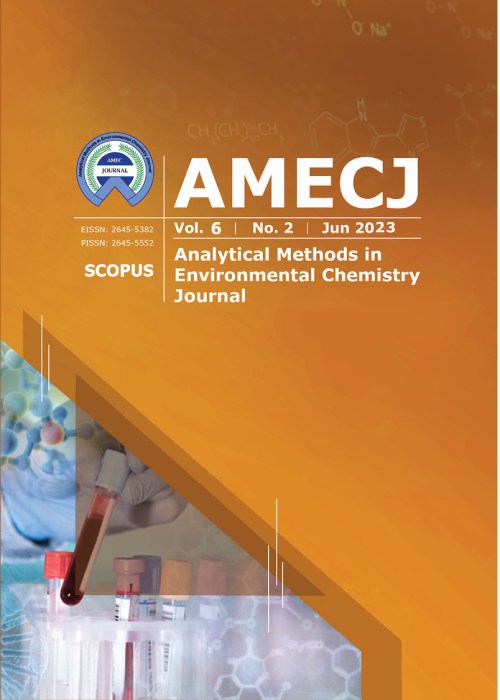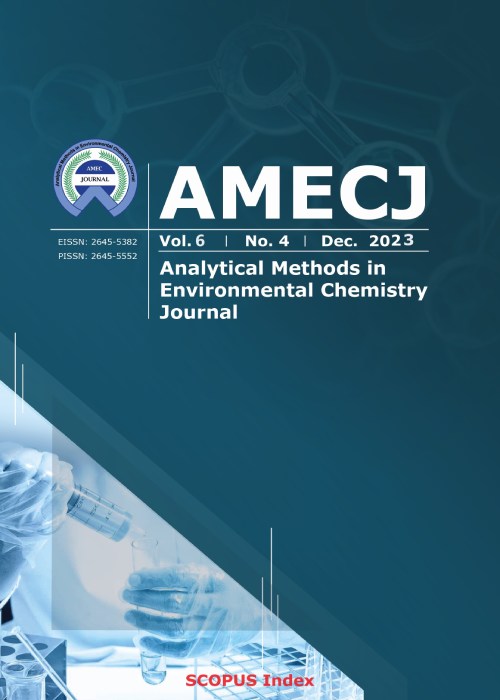فهرست مطالب

Analytical Methods in Environmental Chemistry Journal
Volume:6 Issue: 2, Jun 2023
- تاریخ انتشار: 1402/03/31
- تعداد عناوین: 7
-
Pages 5-17
Turmeric extract and aroma oil of Curcuma longa exhibit inhibition properties against various bacteria, parasites, and pathogenic fungi. We investigated the effects of Ginger (Zingiber officinale) and Turmeric extract on Leishmania promastigotes and used gas chromatography-mass spectrometry (GC-MS) for analyzing plant extracts. The hydroalcoholic extractions obtained from the two plants were diluted in 70% ethanol to three different concentrations; 12.5, 100, and 500 mg mL-1. The Leishmania significant strains were propagated in an artificial medium to reach sufficient parasites. The survival percentage of Leishmania promastigotes was affected significantly by the time and concentration of the extracts (P < 0.05). The repeated measures pattern showed an interaction effect between various time points and treatment with the extracts. Statistics analysis showed a significant difference between different concentrations and extract samples (P < 0.05). GC-MS showed that the survival rate of Leishmania promastigotes treated with hydroalcoholic extract of Ginger at 3-time points (24, 48, and 72 hours) was lower than Glucantime and Turmeric extract. The survival rate of promastigotes treated with Turmeric extract was similar to those treated with Glucantime but lower than those treated with a combined extract of Ginger and Turmeric at a concentration of 500 mg mL-1.
Keywords: Analyzing plant extracts, Anti Leishmanial, Leishmania Promastigotes, Turmeric, Ginger, Gas chromatography-mass spectrometry -
Pages 18-30
Iron is essential heavy metal in trace quantities, but its excessive concentration as Fe2+ is present in effluents from s teel mills, iron ore mines, and metal processing indu s tries, which pollute the groundwater. Among other conventional methods, sorption by natural biomass is a low-co s t alternative for iron seque s tration from an aqueous solution. The root of a native weed plant Calotropis Procera was used to optimize the adsorption parameters like pH, contact time, sorbent dose, and initial adsorbate concentration. Competitive adsorption of Fe2+ in the presence of cations (Ni2+, Cd2+, Cr3+, Zn2+, Ca2+, Mg2+, As3+) and anions (Cl-, SO4 2- , F-) was also s tudied. Batch adsorption s tudies were carried out to evaluate adsorption isotherm by Langmuir and Freundlich isotherm models. Leaching of biomass significantly improved iron uptake capacity from 15 mg g-1 to 80 mg g-1. The kinetics of the reaction was fa s t, with equilibrium conditions attaining in 30 minutes. FTIR s tudy of the biomass revealed the presence of -COOH, -NH groups responsible for the metal binding mechanism. The biomass could be successfully regenerated with 0.1 M HNO3 for further use. Successful removal of iron from simulated acidic water was done under optimum conditions. In this s tudy, absorbance was measured by a UV-Visible spectrophotometer at 523 nm.
Keywords: Fe(II) Adsorption, Leached biomass, Calotropis Procera, Indu s trial effluents, UV-Visible spectrophotometer -
Pages 31-41
Sarafloxacin (SAR) is an antibiotic from the fluoroquinolone group and is also one of the mo s t widely used antibiotics in veterinary medicine. Potential performance and appropriate effectiveness have made SAR a special place among antibiotics. Antibiotic residues in the environment cause many problems, the mo s t important of which is antibiotic resi s tance. Therefore, it is necessary to remove antibiotic residues from the environment. Response surface methodology (RSM) was utilized as a mathematics and s tati s tics approach to optimize the removal efficiency of SAR using the catalytic ozonation process. The obtained regression equation for the response was the quadratic mathematical model. The coefficient of determination (R2), adju s ted R2, and predicted R2 were obtained at 0.9939, 0.9917, and 0.9855, respectively. The maximum removal efficiency of 99.3% was obtained under optimum conditions, including a SAR concentration of 30.0 mg L-1, ozone dose of 1.5 mg min-1, cataly s t dose (modified activated carbon) of 600 mg L-1, pH of 5.0, and reaction time of 30 min. According to the obtained results, the catalytic ozonation process as a suitable technique can efficiently remove SAR and other pharmaceutical compounds.
Keywords: Sarafloxacin, Catalytic ozonation, Modified activated carbon, Removal, UV-Vis spectrometer, Aqueous solution -
Pages 42-54
The aquatic environment may be seriously harmed when cargo gases, diesel, and their compounds leak or are accidentally spilled onto the water’s surface. Oil exploration also leads to water contamination. The remaining oil coats the water’s surface, resulting in the formation of a thin emulsion of water and oil. Three novel compounds with long chains of linear alkyl groups were grafted to flexible polyurethane (R-FPU) to clean up oil spills. The sorption te s ting was thoroughly examined and contra s ted with the aid of crude oil, diesel fuel, and water-oil sy s tems. It was found that as compared to ungrafted FPU, the chemical sorption of crude oil and diesel fuel was boo s ted by modified FPU cubes, while water sorption was reduced by roughly 57%. The sorption competence of the modified FPU was highly correlated with the length of the alkyl chain, with the longer alkyl chain significantly increasing sorption capacity. The results demon s trate that oil may be successfully cleaned using modified FPU cubes.
Keywords: Sorption, Chemi s try method, Grafted polyurethane, Spill remediation, Aquatic environment -
Pages 55-71
In this paper, phenol was determined in a liquid solution based on fabricating a phenol-selective electrode by cyclic voltammetry (CV). The carbon pa s te electrode was modified with nickel oxide nanoparticles (NiO) which were doped with nitrogen carbon quantum dots (NCQD) as the NiO-NCQD nanocomposite. The modified carbon pa s te electrode was manufactured in a laboratory and the effect of pH was s tudied. In the optimized condition, the be s t results were created at pH 7.0 and 4.0 using KH2PO4 buffer solution. By voltammetry, the voltage was optimized, and the be s t value for the voltages was obtained at 0.04166V and 0.05991V for pH 4 and 7, respectively. The scan rate (SR) was s tudied and the be s t SR was achieved at 100 mv s-1 for both pH. Due to the results, a wide linear dynamic range between 10 to 1000 μM was obtained. Also, the s tandard phenol solution was analyzed by high-performance liquid chromatography (HPLC). The retention time (RT), the wavelength maximum (λ max: nm), and the peak area equation of HPLC were achieved at 2.982 min, 270 nm, and (Area=40420CPhenol+ 43.557), respectively by the concentration range of 0.1-5.0 mg L-1. The modified carbon pa s te electrode with NiO-NCQD was used for determining phenol by cyclic voltammetry and compared with the HPLC technique. The results showed that there was no significant difference between the two methods.
Keywords: Phenol, Cyclic voltammetry, Modified carbon pa s te electrode, Nickel oxide Nanoparticles, High-performance liquid chromatography -
Pages 71-84
Toluene is one of the mos t dangerous and, simultaneously, the mos t consumed subs tances in various factories. Toluene s trongly affects the central nervous sys tem. The numerous side effects caused by exposure to toluene indicate the removal of toluene vapours from the air in the workplace. This s tudy aims to use the removal of toluene vapours from the air using a Fe-MOFs metal-organic subs trate for the firs t time in the world and to inves tigate efficient methods to increase the efficiency of removing toluene vapours from the air. This experimental s tudy was carried out on a laboratory scale. After the iron metal-organic framework (Fe-MOFs) was synthesized, the components affecting the adsorption rate, such as reaction time (5-20 min), initial concentration (100-400 mg L-1), adsorbent amount, and temperature (25-80oC) were analyzed and optimized. Then, the efficiency of removing toluene vapours from the air was determined using a gas chromatography device. The absorption capacity of toluene was obtained by the desired adsorbent, 337.2 mg g-1. Also, the effect of different parameters on toluene absorption was inves tigated and optimized. The maximum absorption for concentration (300 mg L-1), temperature (75oC), and contact time (160s) were obtained as 340 mg g-1, 331 mg g-1, and 325 mg g-1, respectively. The obtained results indicate the suitability of the Fe-MOFs for the absorption of toluene vapours from the air before being determined by gas chromatography (GC-FID).
Keywords: Toluene, Removal, Adsorption, Iron metal-organic frameworks, Gas chromatography -
Pages 85-108
Determining the level of contaminants in rice is very important because it is one of the s taple foods consumed by mo s t people worldwide. Therefore, the quantity of arsenic in rice has become a health concern because rice cultivars have the property of accumulating arsenic in their grains. As a result, various societies have mandated the measurement of arsenic in rice by using different analytical chemi s try methodologies, including atomic absorption spectrometry (AAS, ETAAS, HG-AAS) after sample preparation methods such as solid phase microextraction (SPME) and dispersive liquid-liquid extraction (DLLE). The content of arsenic in rice is an essential prerequisite data to incorporate in the health risk assessment. By having such information, it can be possible to determine the risk ratio calculations and identify which countries produce rice with less risk for human consumption. This review aimed to present the analytical methods used for the analysis of inorganic, organic, and total arsenic contents in rice and introduced the methodology for health risk assessment and its related calculations by using the data of inorganic and total arsenic quantifications in the rice along with the per capita of the consumption of rice.
Keywords: Analytical methods, Arsenic, Rice, Risk assessment, Food Chemi s try, Toxicology


